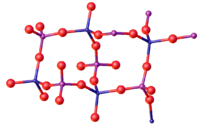Chemistry:Iron(III) phosphate

| |

| |
| Names | |
|---|---|
| IUPAC name
Iron(III) phosphate
| |
| Other names
Ferric orthophosphate, Ferric phosphate
| |
| Identifiers | |
| |
3D model (JSmol)
|
|
| ChEBI | |
| ChemSpider | |
PubChem CID
|
|
| UNII | |
| |
| |
| Properties | |
| FePO4 | |
| Molar mass | 150.815 g/mol (anhydrous) |
| Appearance | yellow-brown solid |
| Density | 3.056 g/cm3 (anhydrous) 2.87 g/cm3 (20 °C, dihydrate) |
| Melting point | 250 °C (482 °F; 523 K) (dihydrate) decomposes[1] |
| anhydrous: insoluble dihydrate: 0.642 g/100 mL (100 °C)[1] | |
Solubility product (Ksp)
|
9.91×10−16[2] |
| +11,500.0·10−6 cm3/mol | |
| Thermochemistry | |
Heat capacity (C)
|
180.5 J/mol·K (dihydrate)[1] |
Std molar
entropy (S |
171.3 J/mol·K (dihydrate)[1] |
Std enthalpy of
formation (ΔfH⦵298) |
-1888 kJ/mol (dihydrate)[1] |
| Hazards | |
| GHS pictograms |  [3] [3]
|
| GHS Signal word | Warning |
| H315, H319, H335[3] | |
| P261, P305+351+338[3] | |
Except where otherwise noted, data are given for materials in their standard state (at 25 °C [77 °F], 100 kPa). | |
| Infobox references | |
Iron(III) phosphate, also ferric phosphate,[4][5] is the inorganic compound with the formula FePO4. Four polymorphs of anhydrous FePO4 are known. Additionally two polymorphs of the dihydrate FePO4·(H2O)2 are known. These materials have attracted much interest as potential cathode materials in batteries.
Structure
The most common form of FePO4 adopts the structure of α-quartz. As such the material consists of tetrahedral Fe(III) and phosphate sites.[6] As such the P and Fe have tetrahedral molecular geometry. At high pressures, a phase change occurs to a more dense structure with octahedral Fe centres. Two orthorhombic structures and a monoclinic phase are also known. In the two polymorphs of the dihydrate, the Fe centre is octahedral with two mutually cis water ligands.[7]
Uses
Iron(III) phosphate can be used in steel and metal manufacturing processes. When bonded to a metal surface, iron phosphate prevents further oxidation of the metal. Its presence is partially responsible for the corrosion resistance of the iron pillar of Delhi.
Iron phosphate coatings are commonly used in preparation for painting or powder coating, in order to increase adhesion to the iron or steel substrate, and prevent corrosion, which can cause premature failure of subsequent coating processes.
It can also be used for bonding fabrics, wood, and other materials to iron or steel surfaces.[citation needed]
Iron phosphate is used[8] to make lithium iron phosphate, the cathode in lithium iron phosphate batteries.[9][10]
Pesticide
Iron phosphate is one of the few molluscicides approved for use in the practice of organic farming.[11] Pesticide pellets contain iron phosphate plus a chelating agent, such as EDTA.[12]
Mineral
Strengite is the mineral form of hydrated ferric phosphate.
Legislation
Iron(III) phosphate is not allowed as food additive in the European Union. It was withdrawn from the list of allowed substances in the directive 2002/46/EC in 2007.
See also
- Iron(II) phosphate, commonly known as ferrous phosphate, the lower phosphate of iron
- Lithium iron phosphate battery, a battery that uses iron phosphate
- Phosphate conversion coating, an industrial process used to protect newly manufactured iron and steel from corrosion
References
- ↑ 1.0 1.1 1.2 1.3 1.4 "iron(III) phosphate dihydrate". http://chemister.ru/Database/properties-en.php?dbid=1&id=4418.
- ↑ John Rumble (June 18, 2018) (in English). CRC Handbook of Chemistry and Physics (99 ed.). CRC Press. pp. 5–188. ISBN 978-1138561632.
- ↑ 3.0 3.1 3.2 Sigma-Aldrich Co., Iron(III) phosphate dihydrate. Retrieved on 2014-05-03.
- ↑ "Iron(III) Phosphate". https://pubchem.ncbi.nlm.nih.gov/compound/ferric_phosphate.
- ↑ "FERRIC PHOSPHATE". http://www.endmemo.com/chem/compound/fepo4.php.
- ↑ Haines, J.; Cambon, O.; Hull, S. (2003). "A neutron diffraction study of quartz-type FePO4: High-temperature behavior and α–β phase transition". Zeitschrift für Kristallographie - Crystalline Materials 218 (3): 193. doi:10.1524/zkri.218.3.193.20755. Bibcode: 2003ZK....218..193H.
- ↑ Zaghib, K.; Julien, C. M. (January 2005). "Structure and electrochemistry of FePO4·2H2O hydrate". Journal of Power Sources 142 (1–2): 279–284. doi:10.1016/j.jpowsour.2004.09.042. Bibcode: 2005JPS...142..279Z. https://www.researchgate.net/publication/245105788. Retrieved 3 July 2014.
- ↑ "Lithium iron phosphate comes to America" (in en). https://cen.acs.org/energy/energy-storage-/Lithium-iron-phosphate-comes-to-America/101/i4.
- ↑ Roncal-Herrero, T., Rodriguez-Blanco, J.D., Benning, L.G., Oelkers, E.H. (2009) Precipitation of Iron and Aluminium Phosphates Directly from Aqueous Solution as a Function of Temperature from 50 to 200°C. Crystal Growth & Design, 9, 5197-5205. doi: 10.1021/cg900654m.
- ↑ Song, Y.; Zavalij, P. Y.; Suzuki, M.; Whittingham, M. S. (2002). "New Iron(III) Phosphate Phases: Crystal Structure and Electrochemical and Magnetic Properties". Inorganic Chemistry 41 (22): 5778–5786. doi:10.1021/ic025688q. PMID 12401083. http://materials.binghamton.edu/whittingham/pdfpapers/IC_41_5778_02.pdf. Retrieved 3 July 2014.
- ↑ "COMMISSION REGULATION (EC) No 889/2008". http://eur-lex.europa.eu/LexUriServ/LexUriServ.do?uri=CONSLEG:2008R0889:20130101:EN:PDF.
- ↑ "The Regional Institute - Slugs, Snails and Iron based Baits: An Increasing Problem and a Low Toxic Specific Action Solution 1". 11 September 2018. http://www.regional.org.au/au/asa/2001/6/c/young.htm.
External links
 |
